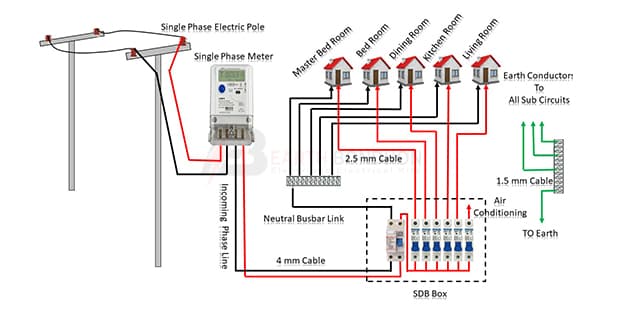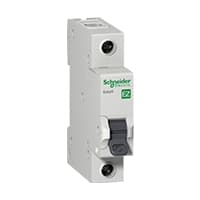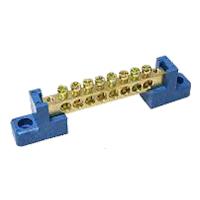Single Phase House Wiring circuit diagram:
This diagram shows how to make Single Phase House Wiring. In this circuit, we use a single-phase energy meter, a DP MCB, and some Singel Pole Miniature Circuit Breaker, an earthing busbar, This circuit is very simple and very easy to make. If you want to know more about this circuit please check our youtube video below the post.
Advertisements
Components needed For this Project:
You can get the components from any of the sites below:
- Single Phase Energy Meter [See Buy Click Amazon]
- DP MCB 32A [See Buy Click Amazon]
- SP MCB 10A [See Buy Click Amazon]
- Busbar wire [See Buy Click Amazon]
*Please note: These are affiliate links. I may make a commission if you buy the components through these links. I would appreciate your support in this way!
Advertisements
Components used to make the Single Phase House Wiring circuit:
A Single-Phase Energy Meter is a sort of Watt-Hour meter. It consists of two Electromagnets. Single-Phase Energy Meter is also Popularly known as a watt-hour meter. 1 Magnet is called the shunt magnet Ml which is Mounted with a Pressure coil. The Pressure coil is a long coil Made of fine Copper wire that is connected across the Supply single-phase line. Single-phase energy meters are suitable for measuring single-phase AC current flow frequencies of 50/60 Hz, which are used for fixed indoor installation systems.
02. DP MCB:
DP MCB In 2 Pole MCB, switching & protection is affected in phases and the neutral. A Double Pole or DP Switch is a Switch that Controls 2 Circuits at the same time. In terms of Residential Switching, this Normally means it Switches the live and Neutral at the same time. In Layperson Terms, Double Pole switches or DP Switches are Exclusively Designed to Control 2 Different Electrical Circuits at the same time, which allows the Appliances to Isolate safely and reliably. Fan or light Combinations and Medical Equipment are some of the many applications for DP Electrical Switches and Electrical components.
In single-pole MCB, Switching and protection are Affected in only one Phase. Single phase supply to break the phase only. A single Pole breaker is Typically used with 120-volt Circuits, and a 6-20 amps Miniature Circuit Breaker. They are constructed with one Line Wire and one Neutral wire. A Single Pole switch is the most basic General-Purpose switch that you use to Control a light or another device from one location. These Switches have 2 Brass-Colored screw Terminals Connected to the hot Power source wires. Pole refers to the number of Circuits Controlled by the Switch SP Switches Control only one Switch Electrical Circuit.
04. Busbar:
A busbar is a type of Electrical conductor. It is made of copper brass or aluminum. Busbar is most commonly used in factories. We supply the power from the transformer to the busbar. We take the electricity from this busbar to the circuit breaker. The advantage of using a busbar is that through it we can provide multiple power connections in multiple places very easily. How many thick copper bars are aggregates of busbars? A copper bar is rectangular (rectangular) copper type or triangular in shape.
Thank You for visiting the website. Keep visiting for more Updates.
Frequently asked questions
Single-phase power is a two-wire alternating current (AC) power circuit. Typically, there is one power supply wire—the phase wire—and one neutral wire, with current flowing between the power supply wire (through the load) and the neutral wire.
Single-phase 3-wire projects and systems (some call them 2-phase or Edison) have 2 hot wires and a neutral wire. This is the most common residential project system in the USA. If you measure from the hot wire to the hot wire you will get 240 volts and if you measure from either hot wire to neutral you will get 120 volts.
Single phase and means you have 2 wires coming from the street, an active wire, usually red, and a neutral wire, as always black. To simplify, in a single-phase power supply, the energy flows in via the active, through your meter and main switch, and onward via RCD/circuit breakers, as into the wiring, and to your appliances.
Single-phase power supply systems only have one neutral wire and 1 power wire with current flowing through them. In a 3-phase project system, there are 3 power wires carrying the load. Because of the structure of a single-phase project system, there are peaks and dips in the power supply that change during the cycle.
It consists of three wires, two hots which are 180° out of phase with each other, and a neutral which is really the center tap of the isolation/step-down transformer. You can measure 240 from hot to hot and 120 from hot to neutral. A ground stake connection is supplied locally and not considered incoming.
Read more Single Phase Wiring
What is a kilowatt-hour (kWh) | kwh formula | What does kwh mean
Introduction to Electrical Units and CircuitskW and kWh on your electricity bill As your home uses electricity during...
What is the Difference Between kVA | What does KVA mean | kVA formula
Difference Between KVA ExplainedWhat does KVA Mean? There are technical terms aplenty when it comes to generators, and...
Power Factor | Power Unit | Energy | Electricity Unit
Power factor definition | Calculating Power FactorPower Factor Values In a purely resistive circuit, the power factor...





0 Comments